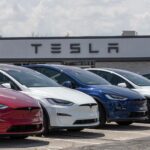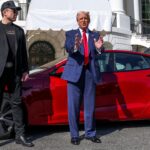
Tesla released its quarterly numbers yesterday, indicating a record for revenue but lower profits as a result of price reduction and incentives. The stock price originally held steady despite the solid financial results, but it began to fall during the earnings call as CEO Elon Musk and other officials were unable to provide exact details and start-of-delivery dates for the eagerly awaited Cybertruck and robotaxi-ready car. The stock dropped by around 5% after hours as a result of the ambiguity surrounding these vehicles and the announcement that vehicle production would slow down in Q3 in order to make facility improvements.
In comparison to the previous year, the company’s net income increased by 20% to $2.70 billion. Operating income, meanwhile, came in at $2.40 billion, down 3% from the same period last year. In contrast, Tesla reported a net profit of $2.51 billion on revenue of $23.33 billion during the first quarter of 2023. Net income for the same time last year was $2.27 billion on $16.93 billion in revenue.
Tesla is still confident it will fulfill its target of 1.8 million vehicles this year, although it anticipates a minor decline in Q3 output due to summer shutdowns for facility upgrades. Tesla reported total vehicle deliveries of 466,140 in the second quarter, which was more than Wall Street anticipated, and produced 479,700 electric vehicles.
Due in part to incentives and discounts, deliveries were greater than anticipated, which resulted in operating margins of 9.6%, the lowest in at least the previous five quarters. 18.2% was the total gross margin, which was still another low for the same time frame.
Tesla attributed the lower margins in the second quarter to reduced average sales prices due to the mix and pricing of the cars it has been selling. Additionally, the cost of ramping up production of battery cells, known as the 4680 cells, designed in-house, contributed to the lower margins.
The company’s core automotive business revenue rose by 46% year-over-year to $21.27 billion, and energy generation and storage revenue rose 74% year-over-year to $1.51 billion. Tesla’s “services and other” revenue, which includes fees for out-of-warranty vehicle repairs, rose 47% to $2.15 billion, supported by more vehicles on the road.
Looking forward, Musk declined to give specific information on whether Tesla’s automotive gross margins would stabilize or rise in the future after price cuts and factory improvements. Instead, he emphasized the importance of autonomy and its potential to impact the numbers significantly in the long term.
Tesla is also investing in research and development, with a focus on being at the forefront of AI development. The company has started production of its Dojo “training computers,” a supercomputer developed for AI machine learning and computer vision training.
Tesla revealed that “factory tooling” for the much anticipated Cybertruck is on schedule, but it is now creating “release candidate” builds. According to Musk, the Cybertruck would feature 10,000 distinct parts and processes in addition to a ton of new technology. Although it can be difficult to forecast the early ramp-up, Tesla intends to produce the Cybertruck in large quantities the following year and deliver the vehicle this year.
Tesla’s progress on self-driving technology was also a topic of discussion during the earnings call. Musk reiterated his belief that Tesla would be better than human at self-driving by the end of this year. The company is focused on developing self-driving tech for the U.S. market.
Musk discussed the hypothetical pairing of a Tesla robotic limb or leg with a Neuralink brain implant in a more futuristic manner. Through the creation of a highly capable and reasonably priced cyborg body, this integration might grant amputees amazing powers.
Despite certain difficulties and unknowns, Tesla’s earnings report demonstrates the company’s ongoing development and progress in a number of areas. While working to increase profits and complete its ambitious initiatives, Tesla continues to be a dominant player in the electric vehicle sector and pushes the boundaries of AI and technology.
Discover more from TechBooky
Subscribe to get the latest posts sent to your email.





